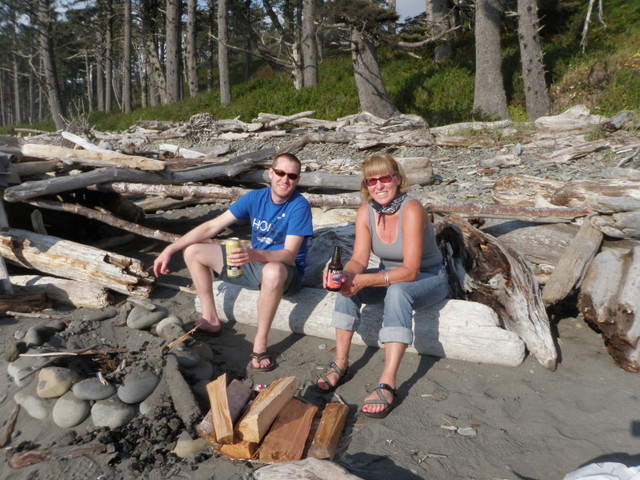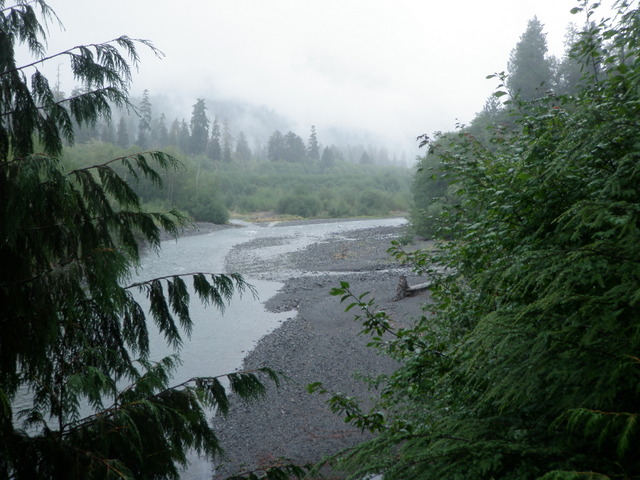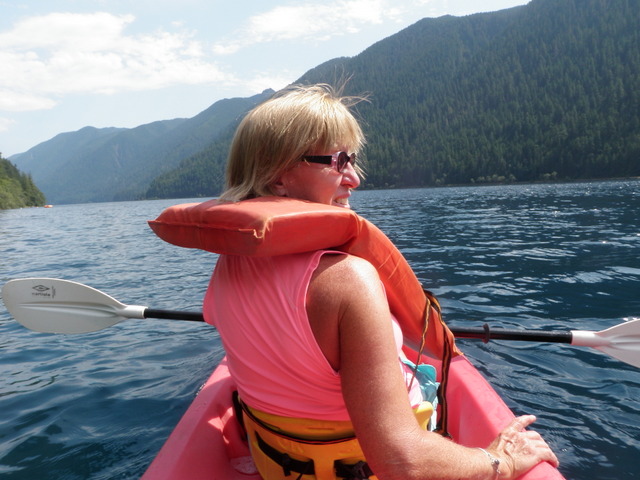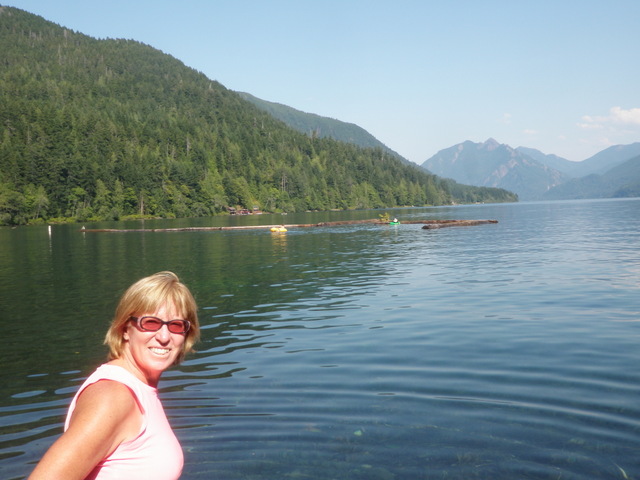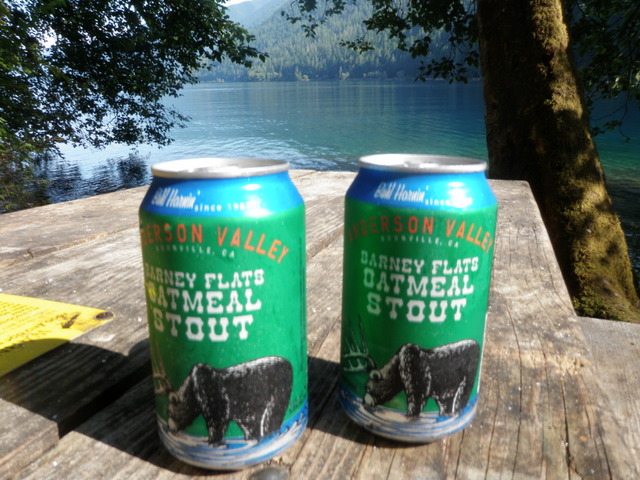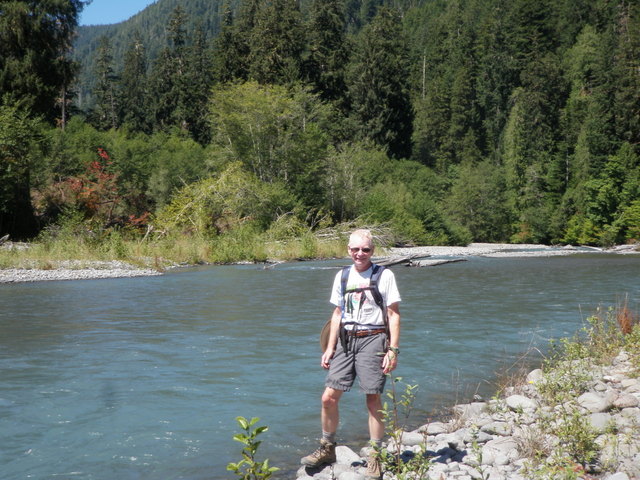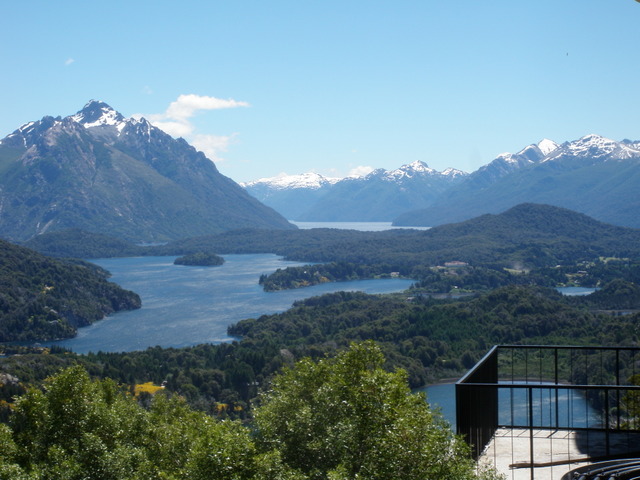Big Bend National Park 03/22/2015 Photo Album
Jane and I woke up on Sunday morning to a damp and cool campsite after the late heavy rain on Saturday, although we were confident that things would dry out rapidly once the sun peeked over the hills on the eastern horizon. For some reason breakfasts cooked outside on a camp stove always taste better than a comparable meal prepared in the home kitchen. This was the case on Sunday as Jane produced delicious fried eggs and bacon.
Bacon and Eggs Outdoors Taste Better
We were both extremely excited to begin our Big Bend adventure, so we decided to pay a visit to the small Rio Grande Village visitor center first. A park service ranger manned the counter, and we began assaulting him with questions. The Persimmon Gap entrance station was closed when we passed through on Saturday, so we discovered that we needed a park pass. Fortunately I possess a Senior Pass, so we avoided a fee and received a sticker to display on the windshield. Next we peppered the ranger with numerous questions about Big Bend. There are three main areas to explore; Rio Grande Village, Chisos Basin, and Santa Elena Canyon, and we were attempting to plan what days to visit each.
Quickly the ranger explained that the Santa Elena Canyon area was closed as a result of the heavy rain on Saturday. Terlingua Creek enters the Rio Grande at the mouth of the canyon, and normally this is a dry creek bed, but it was now a muddy torrent, and flooding turned sections of the paved road into small ponds. With this information we decided to defer Santa Elena until our last day in the park, Tuesday. By process of elimination we elected to explore the sites near Rio Grande Village on Sunday, travel west to Chisos Basin on Monday, and then hopefully visit Santa Elena on Tuesday after the environment had an opportunity to dry out.
We now queried the helpful gentleman on what activities were available to us in the vicinity of Rio Grande Village. He began by suggesting a Rio Grande crossing as apparently a small ferry transported visitors across the Rio Grande to Mexico. Once upon the opposite shore a mule ride or taxi service could be purchased for a small fee, and these modes of transportation allowed one to visit the small Mexican village of Boquillas. He suggested we could purchase lunch or drinks in the village before returning to the U.S. Since I have never set foot in Mexico, I was quite excited about this prospect until we realized that we did not have our passports with us. Naturally this was a deal breaker so we moved on to the other options.
Scorpion Art at the Boquillas River Crossing
Other possibilities included hiking the trail to Boquillas Canyon, a nature trail that began at our campground, a visit to the hot springs along the Rio Grande, a bike ride on Old Ore Road, and a visit to the Daniels Ranch. This sounded like a day’s worth of activities so we thanked the ranger and departed for the Boquillas Canyon trailhead. On the way we drove a short distance down a side road and checked out the federal port of entry for the ferry crossing. It looked rather secure, so we were convinced that a crossing was impossible without a passport. Next we reached the parking lot at the Boquillas Canyon trail.
The Trailhead
An Illegal Alien I Suspect
We lathered up with sun screen and changed to hiking boots and began a short .7 mile hike that led to the Rio Grande River. As we crested a short hill, we encountered a young Mexican man standing next to his horse. He greeted us, and we guessed that for a small donation he was available for photo poses with the river and Mexico in the background. Also there were several places along the path where residents of Boquillas placed crafts such as decorated walking sticks and wire sculpture on rocks with signs suggesting dollar donations. We guessed that the gentleman with the horse may have crossed the river illegally to display these wares that tourists might purchase.
The End of the Trail
Near the end of the path we descended to a sandy area, and as we made our way down the wet trail, another Mexican serenaded us in Spanish from a rock cliff on the other side of the river. We were not sure how this gentleman expected to make money from his performance, but it gave our venture a Latin aura. The trail ended at the sand dune slide, but no signs informed us of this, so we attempted to penetrate the canyon via a narrow path that cut through some willows and brush, but we only managed a short distance before the trail faded, and we were blocked from farther progress by a high vertical rock wall.
The return hike was uneventful, and when we reached the car we reversed our direction and returned to the campground where we found the beginning of the Rio Grande Village nature trail a short distance from our campsite. The Boquillas Canyon hike was relatively short, so we decided to explore the nature trail before lunch. Initially the trail crossed some metal floating bridges that spanned a wetland area. I spotted pods of fish in the murky water, and these fish rose occasionally for some sort of aquatic insect. We later asked a ranger what sort of fish they were, and he informed us that they were non-native tilapia.
The Start of the Rio Grande Nature Trail from the Campground
After crossing the pond we ascended a bit and then were faced with a split in the trail. Left took us on a short loop around the hill, and right led to the edge of the Rio Grande. We had already been to the shores of the muddy river, but we elected to repeat the experience and chose the right branch. Sure enough after a short hike we were next to the river, and it was still muddy and no more impressive than it was at the canyon mouth. We attempted to find the official trail to loop back to the hill, but we ended up confused by numerous unofficial spurs that eventually led to dead ends. Eventually we found a better defined trail and circled behind the hill and ascended the northeast slope until we were perched on a nice overlook. From this vantage point we could see the wetland area, the river and the Rio Grande campground.
Rio Grande, Wetlands, and Campground
After lunch we jumped in the car and drove to the parking area for the hot spring pool. The dirt road was a bit precarious, as we crossed two large puddles, and we were not certain how deep they were. After .5 mile however we reached a small parking lot and began another short hike to the hot springs. Apparently a family settled at this spot and built the concrete pool and also constructed a motel of sorts that was now abandoned. The owner marketed the area as a health spa and touted the recuperative powers of the hot springs. Jane and I peered into the rooms in the abandoned motel and noticed the remaining murals on the side walls of each room.
The Hot Springs Next to the Chocolate Rio Grande
The trail to the pool was less than half a mile, and we arrived there rather quickly and discovered a group of ten to fifteen tourists wading and floating in the natural pool. The Rio Grande River was a thick chocolate color, and it churned by within five feet of the pool. The pool itself was a bit murky, but much clearer and inviting than its source of cool water – the river. Jane and I had our Chacos on, so we waded into the edge of the pool, and the water was indeed quite warm and probably registered 105 degrees as mentioned in the park guide.
More Blue Bonnets
After our soak we returned to the campsite, but we were not yet ready to rest, so we jumped on our mountain bikes and set out to explore the area on two wheels. We left the campground and pedaled out the access road until we reached the main two lane road that linked Panther Junction with Boquillas Canyon. We turned left and climbed a fairly steep hill toward the tunnel, and then turned into the Rio Grande Overlook parking lot and hiked a short distance to the viewing area. After a few minutes we enjoyed a downhill cruise back to the campground area, but his time we turned right at the T intersection across from the store and cycled past the RV parking lot to a small grassy picnic area. The trees and green grass in this location indicated that the irrigation system built by early settlers was still in use.
We found a nice grassy spot and rested when we spotted a pretty red bird perched on a dead branch, and as we marveled at the bird’s bright colors, a couple strolled along from the path that led to Daniels Ranch. We pointed out the “cardinal” on the branch, and they informed us that it was a vermillion fly catcher. We chatted a bit and discovered that their names were Cheri and Howard Ferguson, and they lived in Spokane, WA until nine months ago when they sold everything and bought a Mercedes camper van and embarked on a journey across North America. Howard was a wildlife biologist who worked for the state of Washington with a focus on….birds. As luck would have it, they reserved the campsite next to us back at Rio Grande Village.
It was a busy day, and we were happy to return to our campsite to enjoy a beer and another delicious meal. We enjoyed quite a few adventures on our first day in the park, but we both felt that the warm March weather and the desert plants were the true attractions. Tomorrow we would be off to the high country of Chisos Basin where the highest point in the park towered at 7,832 feet.










